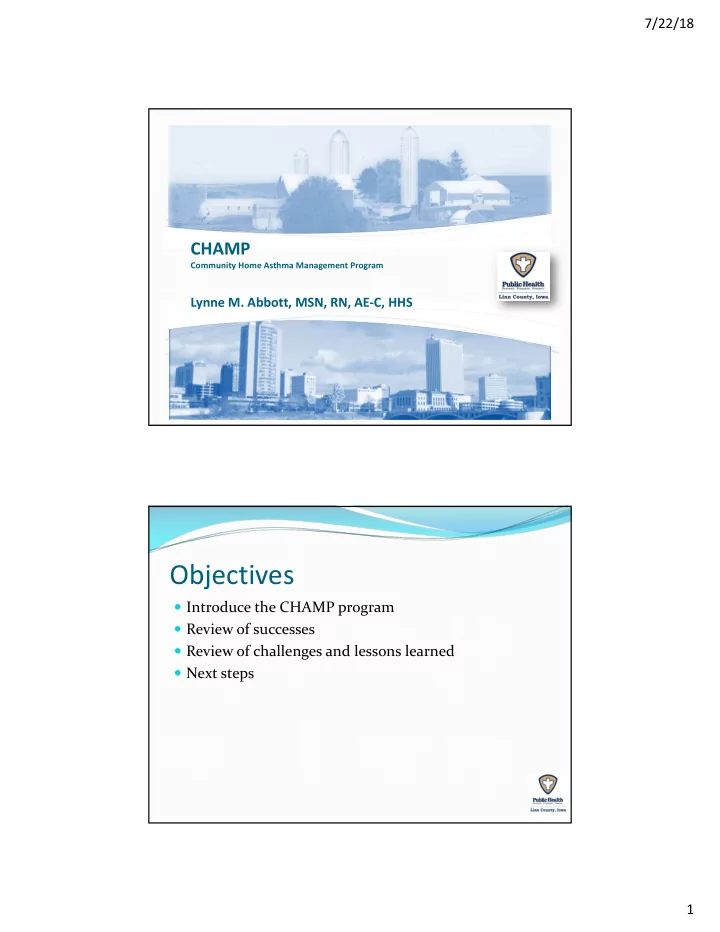

7/22/18 CHAMP Community Home Asthma Management Program Lynne M. Abbott, MSN, RN, AE-C, HHS Objectives Introduce the CHAMP program Review of successes Review of challenges and lessons learned Next steps 1
7/22/18 Linn County Iowa Largely rural Have the second largest city in the state Population of 215,000 Mostly white, but minority groups are rapidly growing Median household income is $6000 higher than the median income in the United States 87.2% of Linn County live in urban areas with the remaining 12.8% living in rural areas Prevalence of Asthma Linn Estimated Children EIHC Estimated Estimated County Asthma age 0-17 Population EIHC EIHC Severe Population Prevalence with severe Children 0-17 Asthma asthma Children Among asthma in with Children children aged 0-17 3 Children Linn diagnosed with severe that have County. 1 asthma 1 (based on Asthma inadequate ED visits) 2 control 1 51,847 3007 571 274 52 10.4 2
7/22/18 2010 Asthma & Wheezing Symptoms What is the CHAMP program? Child or adult with diagnosed asthma Child or adult (not diagnosed with asthma) had asthma or wheezing symptoms in last 12 months Referred by practitioner Home visit with environmental assessment Children-3 visits and follow-up phone call Adults-1 visit 3
7/22/18 Attachments to Referral Form Medication List Asthma Control Test Asthma Action Plan Clinical Summary Home Visit Asthma medications Asthma action plan Indoor air quality/air sampling Respiratory/asthma triggers How to identify and control for triggers Home assessment 4
7/22/18 3 Visit Model Visits will be spaced 1-2 weeks apart 1-green cleaning kit with safe cleaning recipe guide ($30) 2-mattress encasement, pillows/pillow encasements, furnace filters, garbage cans ($100) 3-vacuum, air conditioner, dehumidifier ($250) Follow-up phone call 30 days after completion of visit 3 $25 gift certificate to local grocery store (cannot be used for alcohol, tobacco, lottery, pharmacy) Home Assessment Hazards 1-Damp and Mold growth 21- Falling on Stairs 2-Excess Cold 22-Falling Between Levels 3- Excess Heat 23-Electrical Hazards 4-Asbestos, Silica and other MMF 24-Fire 5-Biocides 25-Flames, Hot Surfaces 6-Carbon Monoxide and fuel combustion products 26-Collision and Entrapment 7-Lead 27-Explosions 8-Radiation 28-Position and Operability of Amenities 9-Uncombusted Fuel Gas 29-Structural Collapse and Falling elements 10-Volatile Organic Compounds 30-Ventilation Practices 11-Crowding and Space 31-Pets 12-Entry by Intruders 32-Smoking 13-Lighting 33-Safety 14-Noise 34-Heating/Cooling System 15- Domestic Hygiene, Pests and Refuse 35-Asthma Recommendations 16-Food Safety 36-Air Cleaning Device 17-Personal Hygiene, Sanitation and Drainage 37-Chickens/Farm Animals 18-Water Supply 38-Wood Smoke 19-Falls Associated with Baths 39-Home Appliances 20-Falling on Level surfaces 40-Candles 5
7/22/18 Healthy Homes Assessment Report Photos Recommendations Used to give to the enforcement agency Given to landlord as written notice 6
7/22/18 7
7/22/18 8
7/22/18 9
7/22/18 10
7/22/18 11
7/22/18 Challenges Turnover of staff at our FQHC Transient clients Fear of a government agency coming into their home 12
7/22/18 Successes Funding for incentives Air quality fines and penalties SIM Grant One agency or hospital cannot fix our health care system Work together and communicate in a way to improve outcomes and reduce costs Can’t focus on just one part of an individual but rather, the whole individual, SDH too Take away messages What will work for your clients Even a little improvement is improvement If something doesn’t work try again 13
7/22/18 Lynne M. Abbott MSN, RN, AE-C, HHS Linn County Public Health 501 13 th St NW Cedar Rapids, Iowa 52405 319-892-6021 lynne.abbott@linncounty.org 14
Recommend
More recommend